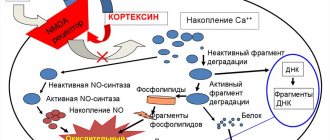Quetiapine
Chemical group: Quetiapine (Seroquel) is a dibenzothiazepine compound.
Release form: tablets 25, 100, 200, 300 mg
Pharmacokinetics: half-life - 7 hours, peak and stabilization of concentration 1.5 hours and 2 days, respectively.
Dosage regimen: Most psychiatrists recommend a gradual increase in quetiapine doses. Initially, the drug is prescribed 25 mg orally twice a day with meals or outside meals. If the drug is well tolerated, the dose is adjusted to 50 mg twice. on the second day, then up to 100 mg twice daily. by 150 mg twice daily on approximately the fourth day of therapy. The average effective daily dose is 300-450 mg in several doses, less often the drug is prescribed at a dose of 150-850 mg/day. If there is no effect within three weeks, the dose of the drug is increased to 600-800 mg per day or more and then, having achieved a positive effect, it is gradually reduced.
According to some researchers, the initial daily dose of quetiapine should not be high due to possible severe sedation and drowsiness. Quetiapine is believed to require a slower dose increase than risperidone and olanzapine. In this case, the daily dose for the first four days of therapy is 50 mg (day 1), 100 mg (day 2), 200 mg (day 3), 300 mg (day 4).
More recent work suggests that the initial daily dose of quetiapine may be higher for the treatment of an acute episode of schizophrenia. On the first day, this dose may correspond to 150-400 mg; 500 mg or more on the second day (Peuskens J. et al., 2007).
In the elderly and in patients with liver disease, the drug is used with caution, starting with 25 mg, with a daily dose increase of 25-50 mg.
Mechanism of action: the drug has relatively low affinity (compared to other atypical antipsychotics) for 5HT1A and 5HT2A receptors, moderate to high affinity for alpha1, alpha2 and H1 receptors and lower activity against D1, D2, D3, D4, D5 - dopamine receptors. As a result of the above, quetiapine does not cause significant dopaminergic side effects. At the same time, according to the results of some studies, quetiapine at a daily dose of 800 mg blocks up to 50% of dopamine receptors. Quetiapine, unlike risperidone and olanzapine, quickly binds to D2 receptors and is also quickly released from them (“fast dissociation constant”), hence the lack of effect in terms of the occurrence of extrapyramidal disorders. Some authors associate the future direction of the synthesis of new atypical antipsychotics with the effect of “rapid release of dopamine receptors”.
Indications: Compared to risperidone and olanzapine, the drug is considered a relatively weak antipsychotic, but its effect is dose dependent. According to a number of authors, quetiapine is better tolerated than risperidone and olanzapine; in addition, its use is recommended in the treatment of schizoaffective disorders and for the treatment of patients with schizophrenia who are prone to aggression and socially dangerous actions (Styazhkin V.D., Tarasevich L.A., 2007). According to a number of researchers, quetiapine is almost twice as effective as haloperidol in terms of reducing positive and negative symptoms.
Indications for treatment of schizophrenia with quetiapine:
- Poor tolerability of atypical antipsychotics such as risperidone and olanzapine
- Schizoaffective disorders, comorbid depressive spectrum disorders
- Aggressiveness
- Tendency to develop extrapyramidal symptoms
- First psychotic episode
- Maintenance therapy
Side effects: the most common side effects of quetiapine include dizziness, hypotension, tachycardia, and QT segment prolongation on the ECG.
Side effects of quetiapine:
- Cardiovascular disorders (orthostatic hypotension, tachycardia, QT segment prolongation)
- Neurological disorders (drowsiness, rarely: insomnia, epileptiform syndrome, extrapyramidal symptoms, myalgia)
- Mild gastroenterological, endocrine and metabolic disorders (dry mouth, constipation, dyspepsia, weight gain, decreased levels of thyroid hormones)
Orthostatic hypotension, less often hypertension, is more often observed in elderly and debilitated patients. The drug should be used with caution in persons suffering from cardiovascular pathology, as well as in patients with a history of seizures. Cases of cataracts have been reported in patients receiving quetiapine for a long time.
Side effects of the drug also include mild drowsiness and, less commonly, insomnia. Due to drowsiness, the drug is not recommended for patients who drive. There have been cases of increased severity of obsessive states when taking quetiapine.
When taking quetiapine, dizziness, constipation, dry mouth, changes in liver enzyme levels, mild asthenia, rhinitis, dyspepsia, limited weight gain, headache, and fever occasionally occur.
Extrapyramidal symptoms rarely develop when taking quetiapine. Peripheral edema, priapism, myalgia (pain in the abdomen, lower back) are also noted among the rare side effects of the drug.
In some cases, an increase in serum lipids was noted during treatment with quetiapine. Possible increase in cholesterol and serum triglyceride levels, decrease in thyroid hormone levels (total T4 and free T3).
Compared with other atypical antipsychotics, quetiapine is more likely to cause anticholinergic side effects.
As noted above, the medication can affect the QT segment, so caution is required when using it in conjunction with drugs that affect the conduction of the heart muscle.
Interaction with medications: quetiapine does not combine well with alcohol, thioridazine, phenytoin, carbamazepine, microsomal enzyme inducers, drugs with central activity (barbiturates), potential CYP3A4 inhibitors (ketoconazole and erythromycin).
Return to Contents
Quetiapine
Dizziness
Quetiapine may cause orthostatic hypotension and dizziness, especially during the initial dose titration period. This occurs more often in older than younger patients. Dizziness may increase the risk of accidental injury (falls), especially in older patients, and caution should be exercised.
Patients with cardiovascular diseases
Quetiapine should be used with caution in patients with known cardiovascular disease, cerebrovascular disease, or other conditions predisposing to hypotension. During therapy, orthostatic hypotension may occur, especially during dose selection at the beginning of therapy. If orthostatic hypotension occurs, a dose reduction or slower increase may be required.
Venous thromboembolism
Cases of venous thromboembolism have been reported while taking antipsychotics. Before starting therapy and during therapy with antipsychotic drugs, including quetiapine, risk factors should be assessed and preventive measures taken.
QT prolongation
There was no relationship between quetiapine and persistent prolongation of the QT interval. However, prolongation of the QT interval has been observed with drug overdose. Patients with cardiovascular disease and previously noted prolongation of the QT interval should use caution when using quetiapine.
Caution should also be exercised when using quetiapine concomitantly with drugs that prolong the QT interval and other antipsychotics, especially in the elderly, in patients with congenital long QT syndrome, chronic heart failure, myocardial hypertrophy, hypokalemia or hypomagnesemia.
Children and teenagers
Quetiapine is not indicated for use in children and adolescents under 18 years of age due to insufficient data on efficacy and safety in this population. According to the results of clinical studies, some side effects (increased appetite, increased plasma prolactin concentrations and extrapyramidal symptoms) were observed with greater frequency in children and adolescents than in adults.
An increase in blood pressure was also noted, as well as changes in thyroid function that were not observed in adults.
The effect on growth, puberty, mental development, and behavioral reactions with long-term (more than 26 weeks) use of quetiapine has not been studied. In placebo-controlled studies in children and adolescents with schizophrenia and mania in bipolar disorder, the incidence of extrapyramidal disorders was higher with quetiapine than with placebo.
Convulsions
There were no differences in the incidence of seizures in patients taking quetiapine or placebo. However, as with therapy with other antipsychotic drugs, caution is recommended when treating patients with a history of seizures.
Extrapyramidal symptoms (EPS)
There was an increase in the incidence of EPS in adult patients with depression in the structure of bipolar disorder when taking quetiapine compared to placebo.
Tardive dyskinesia
There is a possibility of an increased risk of developing tardive dyskinesia with increasing duration of treatment and the total cumulative dose of Quetiapine. However, the syndrome can develop after relatively short courses at low doses. Although the prevalence of tardive dyskinesia is higher among older patients, especially older women, it is impossible to predict the likelihood of its development in different patients.
Treatment with antipsychotic drugs can suppress (partially suppress) the symptoms and thereby hide the underlying process. If signs and symptoms of tardive dyskinesia occur, dose reduction or discontinuation of the drug should be considered.
Neuroleptic malignant syndrome
Neuroleptic malignant syndrome may be associated with antipsychotic treatment. Clinical manifestations of the syndrome include hyperthermia, altered mental status, muscle rigidity, lability of the autonomic nervous system, and increased levels of creatine phosphokinase activity. In such cases, it is necessary to discontinue the drug and carry out appropriate treatment.
Severe neutropenia
In clinical studies of quetiapine monotherapy, cases of severe neutropenia (neutrophil count <0.5 x 109/L) without infection were rarely observed. The development of agranulocytosis (severe neutropenia associated with infections) has been reported in patients receiving quetiapine in clinical trials (rare), as well as during post-marketing use (including death).
Most cases of severe neutropenia occurred several months after the start of drug therapy. No dose-dependent effect was found. Leukopenia and/or neutropenia resolved after discontinuation of quetiapine therapy. A possible risk factor for the occurrence of neutropenia is a previous reduced number of leukocytes in the blood and a history of drug-induced neutropenia. The development of agranulocytosis was noted in patients without risk factors. The possibility of neutropenia should be considered in patients with infection, especially in the absence of obvious predisposing factors, or in patients with unexplained fever; These cases should be observed in accordance with clinical recommendations.
In patients with a neutrophil count <1 x 109/L, quetiapine should be discontinued. The patient should be observed for possible symptoms of infection and the neutrophil count should be monitored (until the level exceeds 1.5 x 109/L).
Hyperglycemia
While taking quetiapine, hyperglycemia may develop: an increase in fasting blood glucose ≥ 126 mg/dl (≥7.0 mmol/l) or postprandial blood glucose ≥ 200 mg/dl (≥11.1 mmol/l) at least with a single determination or exacerbation of diabetes mellitus, sometimes accompanied by ketoacidosis or coma, in patients with a history of diabetes mellitus.
Clinical monitoring of patients with diabetes mellitus and patients with risk factors for developing diabetes mellitus is recommended. Regular monitoring of body weight and symptoms of hyperglycemia, such as polydipsia, polyuria, polyphagia and weakness, is necessary in patients taking antipsychotics, including quetiapine.
Plasma lipid concentration
While taking quetiapine, it is possible to increase the concentration of triglycerides and cholesterol in plasma, as well as a decrease in high-density lipoproteins.
Metabolic disorders
Increased body weight, increased concentrations of glucose and lipids in the blood in some patients can lead to a deterioration in the metabolic profile, which requires monitoring. An asymptomatic increase (≥3 times the upper limit of normal) in plasma AST, ALT and GGT is possible, usually reversible with continued use of quetiapine.
Body mass
As a result of a 6-week placebo-controlled clinical trial of quetiapine, there was a more than 7% increase in body weight in patients with schizophrenia when using quetiapine (23% of the quetiapine group compared to 6% of the placebo group), with monotherapy for mania (21% of the quetiapine group vs. compared with 7% of the placebo group), and in combination therapy - 13% of the quetiapine group, compared with 4% in the placebo group. In the treatment of depression as part of bipolar disorder, an increase in body weight was observed in 8% of patients receiving quetiapine, compared with 2% in the placebo group. In this regard, careful monitoring of patients' body weight is necessary.
Sudden withdrawal reactions
If quetiapine is abruptly discontinued, the following acute reactions (withdrawal syndrome) may occur: nausea, vomiting, insomnia, headache, dizziness and irritability. Therefore, it is recommended to discontinue the drug gradually over at least one or two weeks.
Elderly patients with dementia
Quetiapine is not indicated for the treatment of psychoses associated with dementia.
Randomized trials have shown that some atypical antipsychotics increased the risk of cerebrovascular complications by approximately 3 times in patients with dementia. The mechanism for this increased risk has not been studied.
A similar risk of increased incidence of cerebrovascular complications cannot be excluded for other antipsychotic drugs or other patient groups.
Quetiapine should be used with caution in patients at risk of stroke. An analysis of the use of atypical antipsychotics to treat psychosis associated with dementia in elderly patients found an increased mortality rate in the group of patients receiving these drugs compared with placebo. Two 10-week placebo-controlled studies of quetiapine in a similar group of patients (n = 710; mean age 83 years, age range 56-99 years) showed mortality rates in the quetiapine group of 5.5% and 3.5%. .2% in the placebo group. The causes of death were consistent with those expected for this population. No causal relationship has been identified between quetiapine treatment and the risk of increased mortality in elderly patients with dementia.
Liver disorders
If jaundice develops, the drug should be discontinued.
Dysphagia
Dysphagia and aspiration have been observed with quetiapine therapy. A cause-and-effect relationship between taking the drug and the development of aspiration pneumonia has not been established. However, caution should be exercised when prescribing the drug to patients at high risk of developing aspiration pneumonia.
Constipation and intestinal obstruction
Constipation is a risk factor for intestinal obstruction. During the use of quetiapine, the development of constipation and intestinal obstruction, including fatal cases, was observed in patients at high risk of intestinal obstruction, including those receiving concomitant medications that reduce intestinal motility, even in the absence of complaints.
Pancreatitis
During clinical studies and post-registration use, cases of pancreatitis were observed, but a cause-and-effect relationship has not been established. Post-marketing reports have identified data including risk factors for pancreatitis, such as increased triglyceride concentrations, cholelithiasis, and alcohol consumption.
Suicide/suicidal ideation or clinical worsening
In children, adolescents and young adults (under 24 years of age) with depression and other mental disorders, antidepressants increase the risk of suicidal thoughts and behavior. An FDA meta-analysis of placebo-controlled studies of antidepressants, compiling data from approximately 4,400 children and adolescents and 7,700 adult patients with psychotic disorders, found an increased risk of suicidal behavior with antidepressants compared with placebo in children, adolescents, and adults under 25 years of age (this meta-analysis did not include studies using quetiapine). Therefore, when prescribing quetiapine and any other antidepressants in young people (aged 18-24 years), the risk of suicide should be weighed against the benefits of their use.
Any depressive disorder itself increases the risk of suicide. This risk persists until significant remission occurs. According to clinical experience, the risk of suicide may increase in the early stages of remission. Other psychotic disorders for which quetiapine is prescribed are also associated with an increased risk of suicidal events. In addition, such conditions may be comorbid with a depressive episode. Therefore, all patients should be monitored during treatment for early detection of disturbances or changes in behavior, as well as suicidality. When abruptly stopping quetiapine therapy, the risk of suicide should be taken into account. Patients with a history of suicidal events, as well as patients expressing suicidal thoughts before starting therapy, are at increased risk and should be carefully monitored during treatment. According to clinical studies, suicide occurred in 3.0% of patients taking quetiapine versus 0% in the placebo group in persons under 25 years of age.




